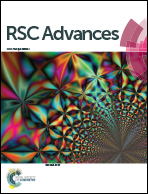Antihyperglycemic and antihyperlipidemic activities of protodioscin in a high-fat diet and streptozotocin-induced diabetic rats†
Abstract
Diabetes mellitus is one of the major health problems all over the world. The aim of this study was to investigate potential hypoglycemic and hypolipidemic effects of protodioscin in diabetic rats. After 4 weeks of feeding on a high-fat diet, rats were injected intraperitoneally with streptozotocin to induce diabetes. Diabetic rats were divided into 5 groups to receive carboxymethylcellulose sodium, metformin (200 mg kg−1), and 3 doses of protodioscin (10, 20 and 40 mg kg−1) continuously for 12 weeks. Blood levels of glucose, glycogen, total cholesterol (TC), triglycerides (TG), non-esterified fatty acids (NEFA), high density lipoprotein cholesterol (HDL-c), low density lipoprotein cholesterol (LDL-c), glycosylated hemoglobin (GHb), insulin, and adiponectin were measured, and glucose tolerance was estimated. The results demonstrated that protodioscin significantly improved glucose tolerance, reduced blood levels of glucose, GHb, TG, TC, LDL-c, and NEFA, as well as increased the content of HDL-c, adiponectin, and glycogen. Histological examination showed that protodioscin ameliorated the disordered liver structure in diabetic rats. Taken together, protodioscin alleviated hyperglycemia and hyperlipidemia in diabetic rats, and thus it can be considered a potential drug candidate for diabetes.


 Please wait while we load your content...
Please wait while we load your content...